14 Patient Intake Form Templates That Get Results

Much as we might wish to, there’s no dispensing with the necessity of patient intake forms.
Patient intake forms furnish essential information — demographics, history of present illness, medical history, etc. — to give the physician a well-rounded picture of the patient’s health so they can provide the best diagnosis and treatment. Other forms, like legal consents and insurance details, ensure patients can pay for services and cover the organization from a legal compliance standpoint.
Patient intake form templates can be quite thorough, and it can take a long time for patients to complete them. Too many fields on a form creates overwhelm, and patients end up ignoring or forgetting them, and you end up with office delays as you collect the missing data. Of course, too few fields means your office doesn’t get the information it needs to effectively provide care.
Below, we provide a number of patient intake form templates and examples you can use to strike a balance between too much and just enough information. Many forms differ by practice and specialty, but the principle remains the same: only ask for what you truly need to know.
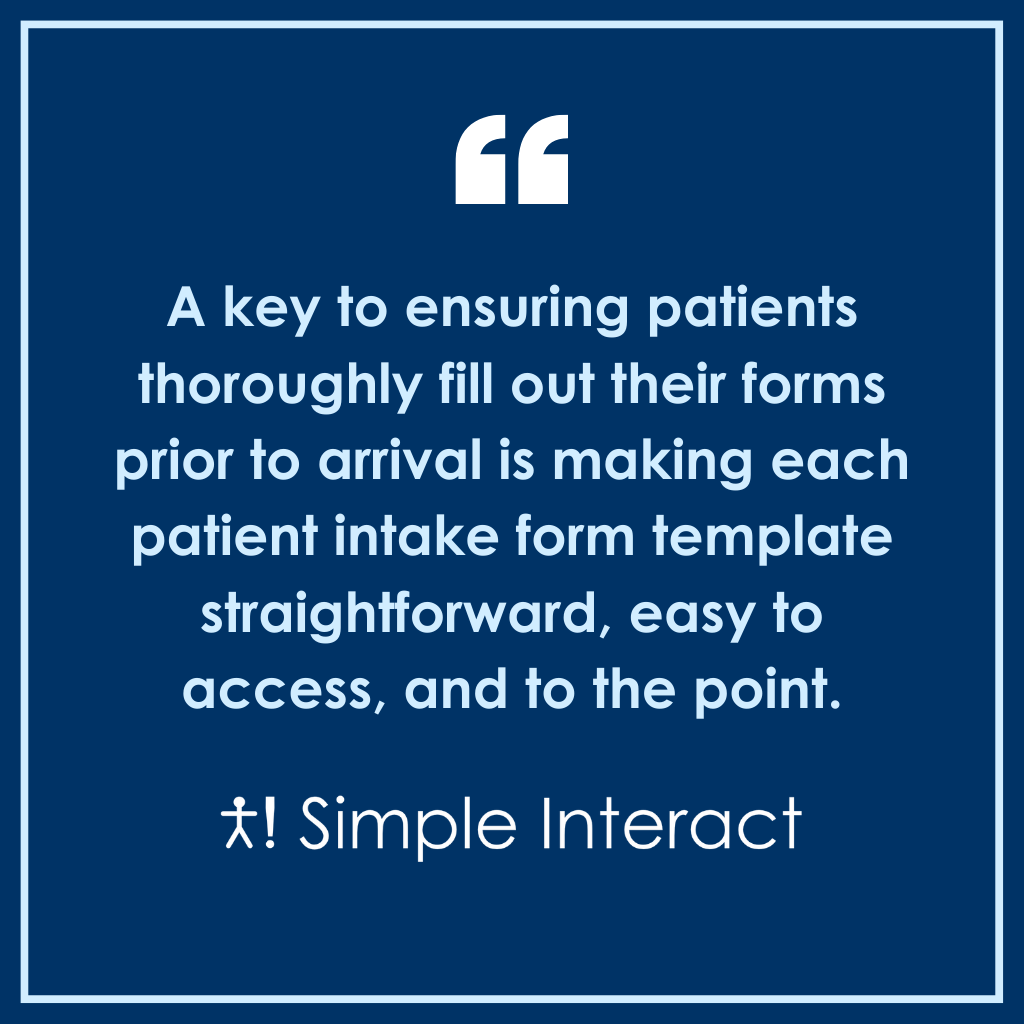
Minimum Questions to Include on Each Patient Intake Form Template
A key to ensuring patients thoroughly fill out their forms prior to arrival is making each patient intake form template straightforward, easy to access, and to the point.
There are probably hundreds of questions you could ask on certain forms, but you don’t really need all that data. Instead, include only the essential questions you really need answered in each patient intake form template.
Below are examples of some common intake forms, and the most crucial information most practices need from each form. Asterisks symbolize an essential field, and a lack of asterisk means the need for a field may vary by practice and preference.
Patient Basic Information
This form collects basic demographic information about the patient and should allow for fill-in-the-blank or drop-down menu answers for the following:
- First Name*
- Middle Name
- Last Name*
- Preferred Name
- Date of Birth*
- Legal Sex*
- Gender Identity
- Preferred Pronouns
- Marital Status*
- Occupation*
- Current Employer
- Employment Status
- Primary Language*
- Race*
- Ethnicity*
- Driver’s License Number
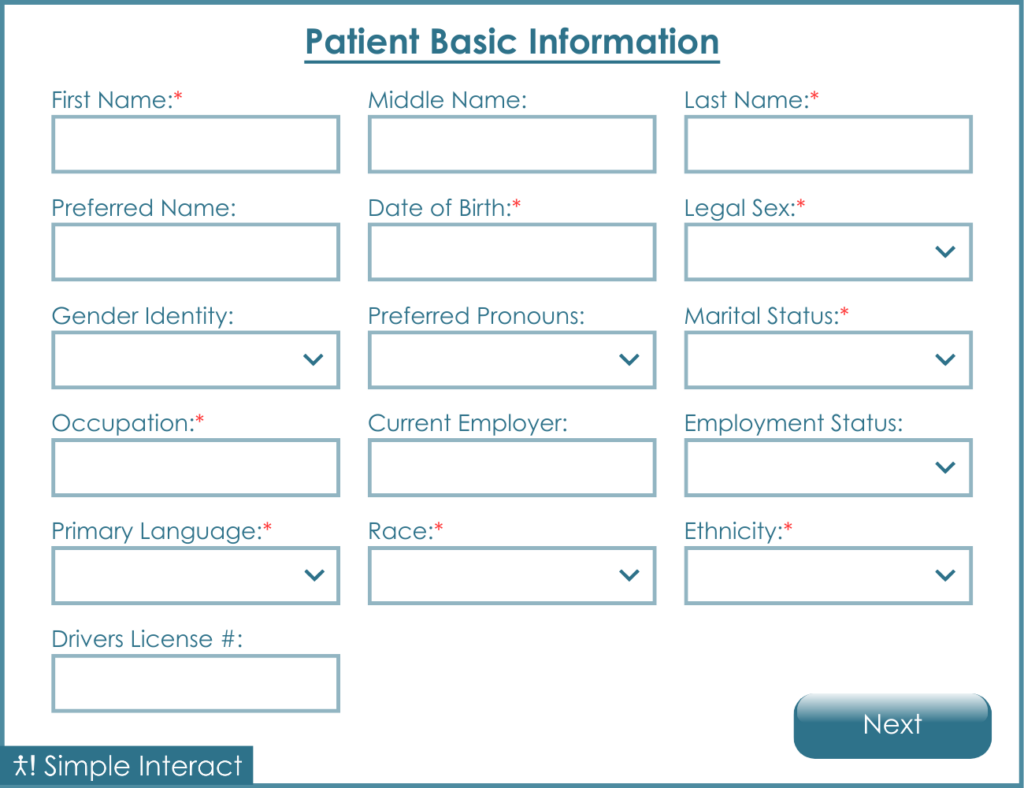
Patient Contact Information
This form collects basic contact information for the patient, so you know how to get in touch with them. These answers should be either auto-populating or regular fill-in-the-blank.
- Street Address*
- Unit Number
- Zip Code*
- Home Number
- Cell Number*
- Work Number
Emergency Contact
This form collects the contact information of a person the patient authorizes your organization to contact in case of an emergency. These answers can either be fill-in-the-blank or selected from a drop-down menu.
- Name*
- Relationship*
- Cell Number*
- Home Number
Financial Policies
Aside from a place to initial and sign the form, your financial policies form won’t include many fields for the patient to complete. Instead, it will list the financial policies of your organization for the patient to read, review, and agree to adhere to.
Information and statements you may wish to include on this form include:
- We understand health coverage is provided through your insurance company.
- If you have out-of-network benefits, we will happily file claims on your behalf.
- You must pay any co-payment or applicable deductible amounts at the time of service unless other arrangements have been made with our office.
- The remainder of your bill will be sent to your health plan for direct payment to our office.
- If your insurance carrier has not paid our claim within 45 days, we will expect payment from you.
- If, by mistake, your health plan remits payments to you, please send it to us along with all paperwork sent to you at the time.
- You are responsible for any amounts and services not covered by your insurance plan.
You may also wish to include a disclaimer that insurance may refuse payment of a claim if:
- This is an illness not covered by your plan.
- You have not met your full deductible for the calendar year.
- Your plan does not cover the type of medical service required.
- The health plan was not in effect at the time of service.
- You have other insurance that must be filed first.
Last, include a disclaimer that financial responsibility rests between the patient and their insurance company. While your office is pleased to file the patient’s medical insurance, if the patient’s health plan denies the claim, the patient is still responsible for paying the denied amounts in full.
Finally, include a statement that reads: “I acknowledge that I have read the above and understand my obligations and responsibilities. I have completed this form with accurate information. I acknowledge that I am fully responsible for supplying the correct insurance information, billing information, and payment of any services not covered or approved by my insurance carrier.”
The patient should initial and sign under this statement.
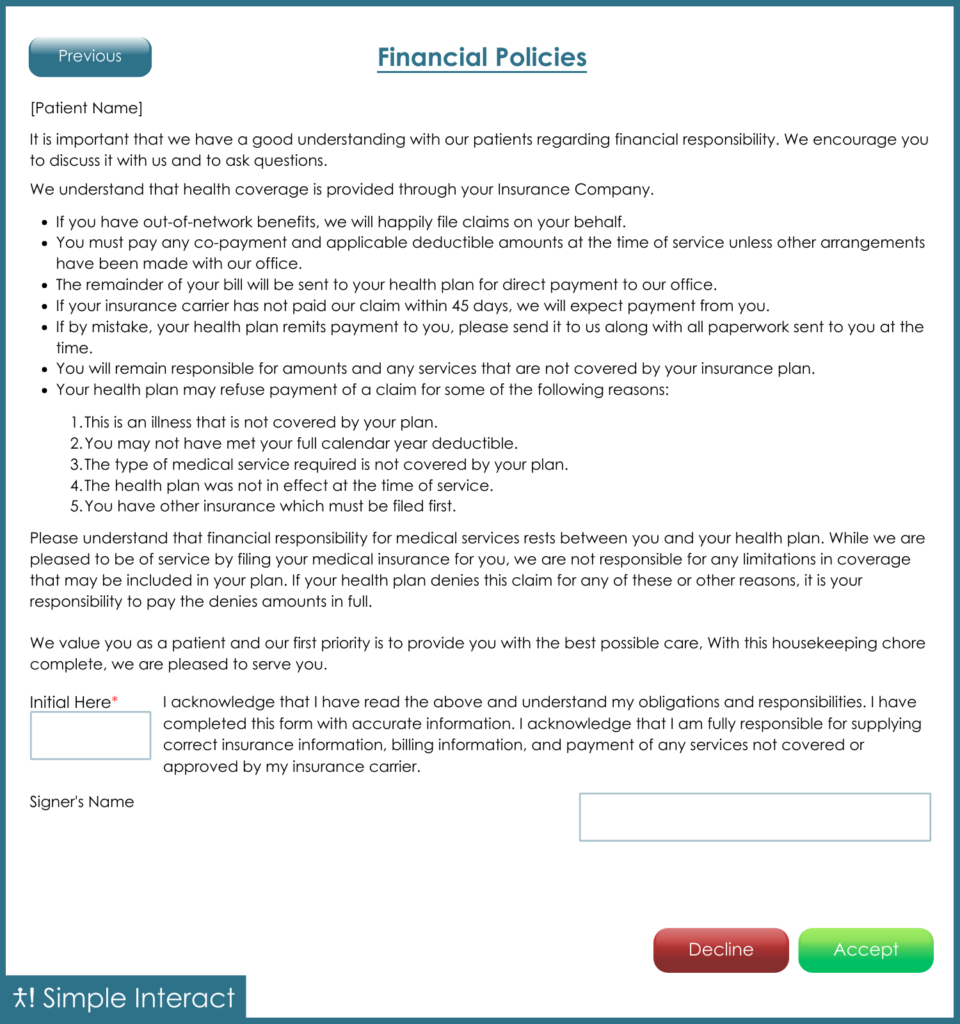
Confidential Communications
The confidential communications form ensures that you communicate with the patient using a method they approve and that you don’t leave confidential information on an unapproved line of communication.
This form should include drop-down menu questions like:
- Preferred Mode of Verbal Communication*
- Permission to* (leave a message with detailed information, etc.)
- Preferred Mode of Written Communication*
At the end of this form, include a required authorization and a place to initial, stating: “I authorize [HEALTHCARE ORGANIZATION] to use the above means of communication. If this changes, I may submit the change in writing at any time.”
Signature Page
At this point, it’s time to collect a final signature that ensures the patient agrees to the following:
- Acknowledgment of Notice of Privacy Practices
- Financial Policies
- Office Policies
- Confidential Communications
- Designation of Representative(s)
Since the patient will complete this form on a mobile phone, tablet, or computer, they can sign the document using their finger, trackpad, or mouse. You should also leave a mandatory field for the signer’s printed name.
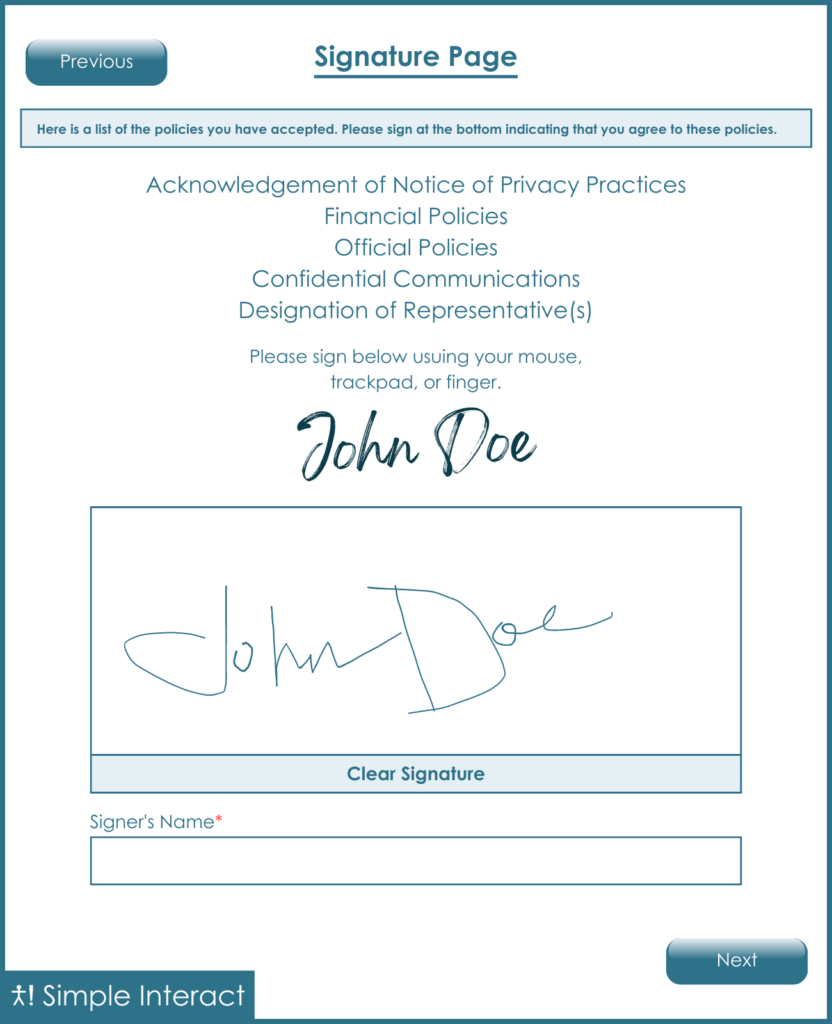
Chief Complaint
Now that your initial patient intake form templates have collected all the patient’s demographic, financial, and legal information, it’s time to collect their health-related information.
This form gathers information with fill-in-the-blank or drop-down menu questions about the patient’s chief complaint and reason for scheduling an appointment with your office. These will vary widely by specialty, but here is an example from an orthopedic practice:
- What is your current age?*
- Dominant Hand*
- Body Part of Primary Complaint*
- Laterality of Primary Complaint*
- Body Part of Secondary Complaint
- Laterality of Secondary Complaint*
- Body Part of Tertiary Complaint
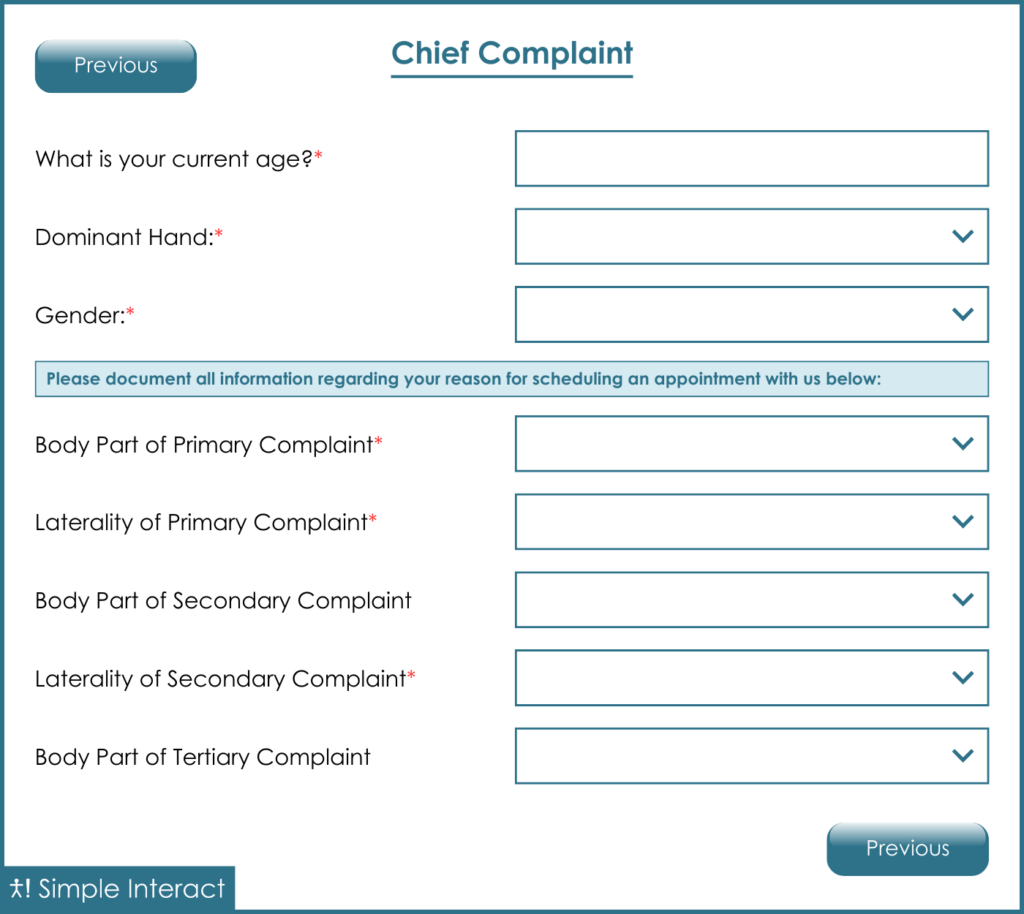
History of Present Illness
This form continues to collect information about why a patient scheduled an appointment with you. Fields on this form include but are not limited to:
- Was your pain caused by an injury?*
- Yes
- No
- Time Since Onset of Symptoms
- Number*
- Duration* (days, weeks, months, etc.)
- Symptoms Associated With Chief Complaint*
- None worth reporting
- Burning
- Difficulty walking
- Headaches
- Pain
- Muscle spasms
- Bladder or bowel incontinence
- Numbness
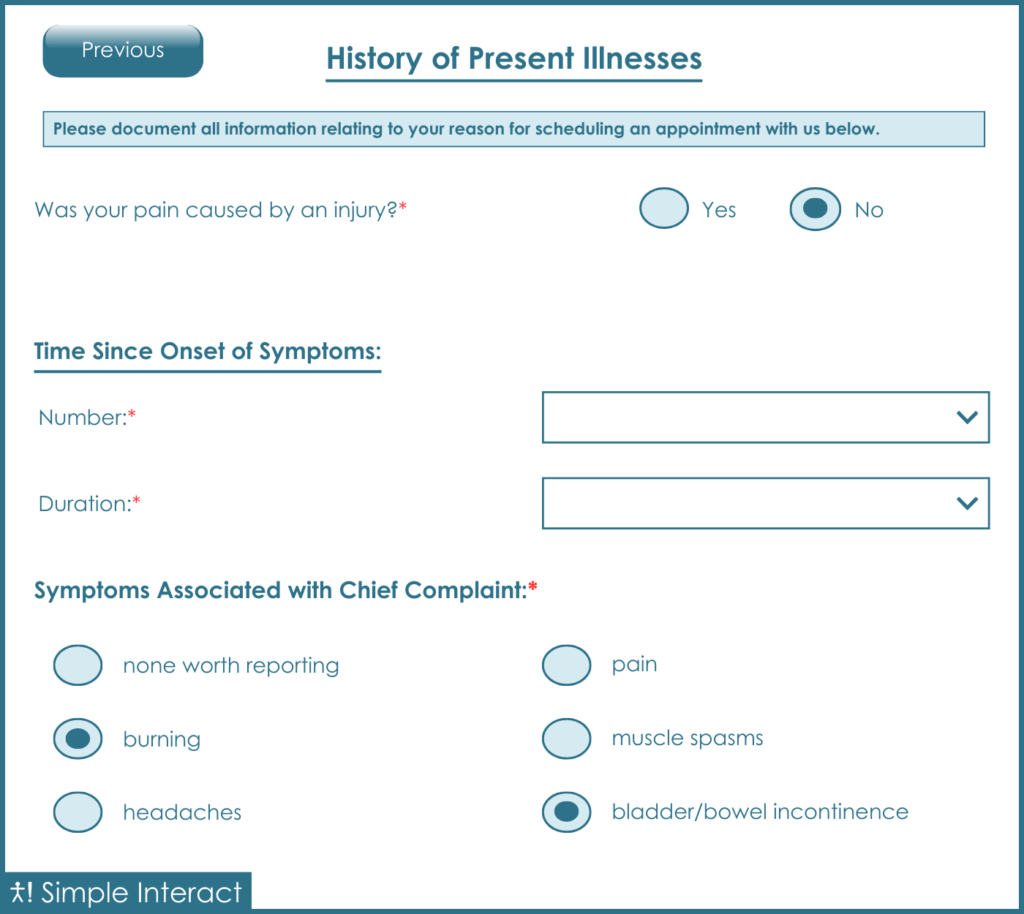
Current Medications
This form should allow the patient to list any medications they are currently taking at the time of the appointment and their amounts. Offering a dropdown or auto-completing these fields based on what the patient types can be very helpful in getting accurate information.
Beside each medication, there should be a place for comments to allow the patient to state important information, like if they only take allergy medication during the spring or pain medication when they have a headache.
The template should also offer a checkbox for if the patient has no medications to report.
Allergies
Just like medications, patients should list any medication or non-medication allergies and their reactions to each allergy. Optional fields where the patient can list the onset date and other comments about the allergy may also be helpful.
Again, a box should be available for patients to check if they have no allergies.
Patient Social History
The patient social history form collects information about the patient’s lifestyle. This form includes either a drop-down menu or “yes” or “no” questions for the following fields:
- What is your smoking status?*
- How many cans of tobacco chew/snuff do you go through in a week?*
- How many years have you used tobacco?
- How many alcoholic drinks do you consume in a week?*
- Do you use non-prescribed or recreational drugs?*
- Are you hard of hearing or deaf in one or both ears?*
- Are you legally blind in one or both eyes?*
- Are you exposed to animals?*
Depression Assessment
This form asks questions to identify whether a patient is struggling with depression:
- Little interest or pleasure in doing things*
- Feeling down, depressed, or hopeless*
- Trouble falling asleep, staying asleep, or sleeping too much*
- Feeling tired or having little energy*
- Poor appetite or overeating*
The patient should be able to mark the following responses for each question:
- Not at all
- Several days
- More than half the days
- Nearly every day
Review of Systems
This form gives the doctor an overview of all the body systems and draws attention to symptoms the patient may be experiencing. Some fields and checkboxes you may wish to include include but are not limited to:
- General*
- Hair loss or hair growth
- Cold
- Hot flashes
- Heat
- None to report
- Allergic / Immunologic*
- Sneezing
- Skin reaction
- Eye irritation / itchiness
- None to report
- Bladder / Kidney / Liver*
- Hesitation when urinating
- Pain when urinating
- Urination at night
- None to report
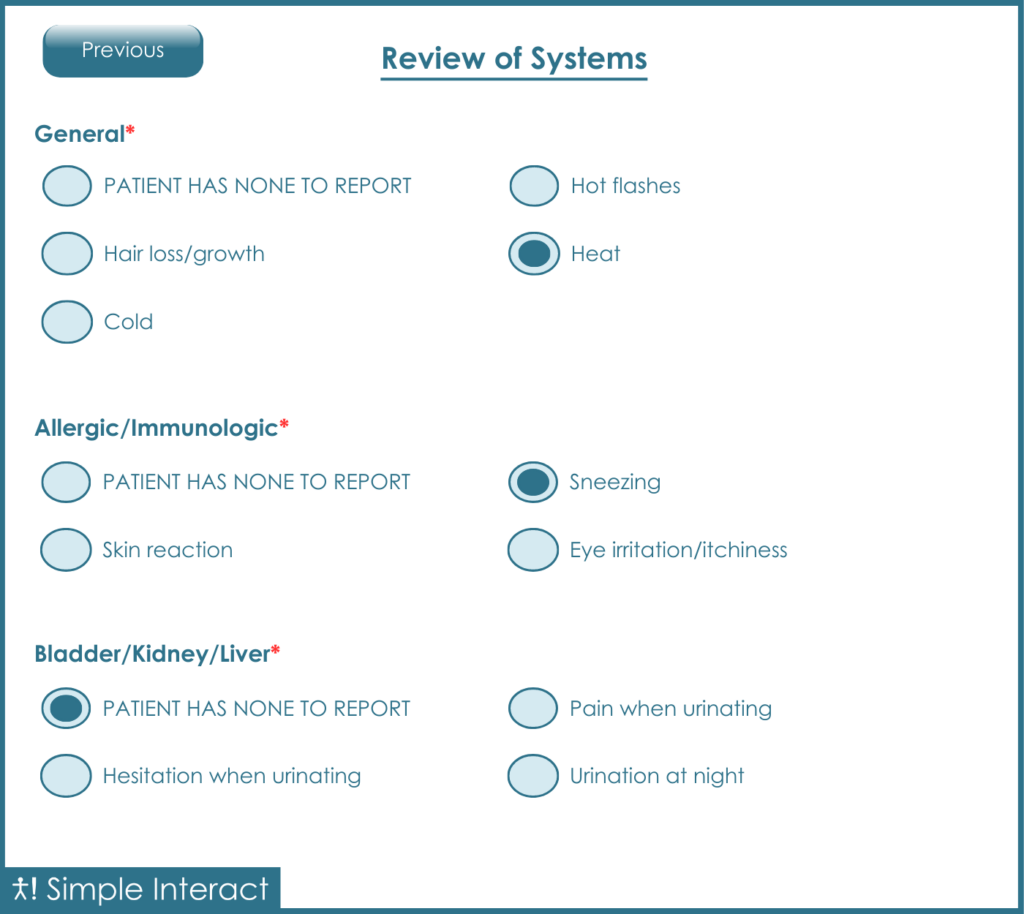
Ad Hoc Consent Forms
Depending on the kind of practice you are and what you offer, you may need certain ad hoc forms. For example, practices that offer telehealth must have patients sign a telehealth consent form prior to their appointment.
If patients opt for a telehealth visit, their consent form might contain the following statements for patients to agree to:
- I understand that my healthcare provider wishes me to attend a telemedicine consultation/visit.
- My healthcare provider’s office has explained to me that the video conferencing technology will be used to effect such a consultation/visit will not be the same as a direct patient/healthcare provider visit because I will not be in the same room as my healthcare provider.
- I understand this technology has potential risks, including interruptions, unauthorized access, and technical difficulties. I understand that my healthcare provider or I can discontinue the telemedicine consult/visit if it is felt that the videoconferencing connections are not adequate for the situation.
- I further understand that I will be informed of any other personnel in the room at the time of my consultation/visit and thus will have the right to request any or all of the following: (1) omitting specific details of my medical history/physical examination that are personally sensitive to me; (2) asking personnel to leave the telemedicine examination room; (3) terminating the consultation at any time.
- I have had the alternatives to a telemedicine consultation/visit explained to me. In choosing to participate in a telemedicine consultation, I understand that some parts of the exam involving a physical examination and/or testing may not be included.
- I understand that billing will occur from my practitioner’s office.
Finally, leave a space to initial the form, allowing the patient to acknowledge that they:
- Have read or had the form read and explained to them.
- Fully understand and consent to participate in telemedicine, including the risks and benefits.
- Have been given ample opportunity to ask questions, and any questions have been answered to their satisfaction.
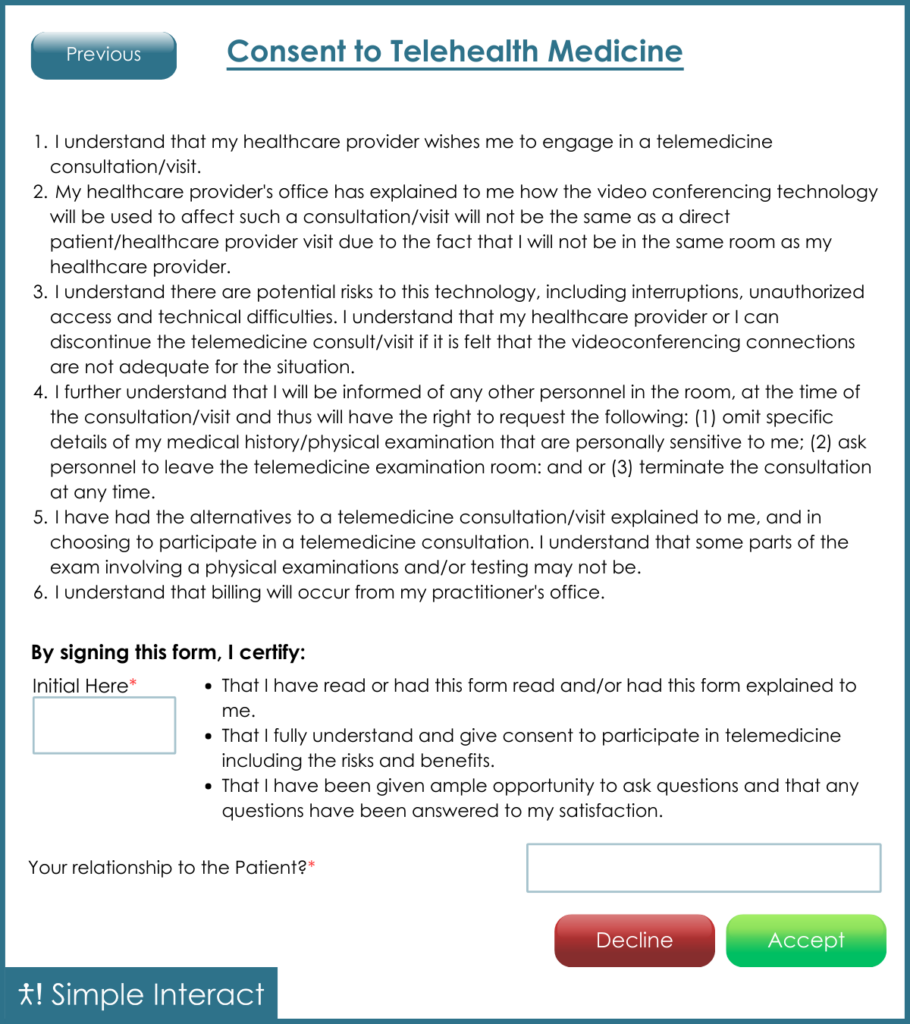
Simple Interact’s Patient Intake Form Templates Make Collecting Data a Breeze
With the detailed and extensive information needed from intake forms, paper forms and manual data entry create a lot of work. Besides the hours of labor, it also introduces greater opportunity for human error (and illegible handwriting).
Digital forms constitute a much more efficient, cost-effective, and time-saving process.
Simple Interact offers digital solutions for patient intake forms that integrate with your EMR. When a patient fills out their digital forms, the data is automatically uploaded to their record, saving your office staff hours of tedious paperwork and manual data entry.
Even better news? Simple Interact has already designed the patient intake form template for you, and we offer white-glove customization to ensure the forms fit each of our unique client’s needs.
If you’d like to see our forms and learn more about how our front-office automation platform works, please contact us to schedule a demo!

Ravi Kalidindi is the Founder and CEO of Simple Interact, a leading Front Office Automation company that helps healthcare facilities across the United States run more efficiently and profitably by boosting staff productivity, reducing provider burnout, and elevating the patient experience. Customers view Ravi as a trusted partner who can quickly comprehend business problems and suggest “keep it simple” solutions that are effective and easier to maintain over time.
Recent Posts
- The Benefits of Using 2-Way SMS Chat for Healthcare Communication
- 2-Way SMS vs. Live Chat: Which Is Best for Bi-Directional Patient Communication?
- Simple Interact Earns A+ Satisfaction Ratings in KLAS Report
- Boosting Healthcare Staff Productivity With a Shared Inbox Dashboard
- Healthcare SMS: What Metrics to Track in Your 2-Way SMS
Categories
Archives
- February 2025
- June 2024
- May 2024
- April 2024
- March 2024
- February 2024
- January 2024
- December 2023
- November 2023
- October 2023
- September 2023
- August 2023
- July 2023
- June 2023
- May 2023
- April 2023
- March 2023
- February 2023
- January 2023
- December 2022
- November 2022
- October 2022
- September 2022
- August 2022
- July 2021
- December 2020
- May 2020
- March 2020
- June 2016